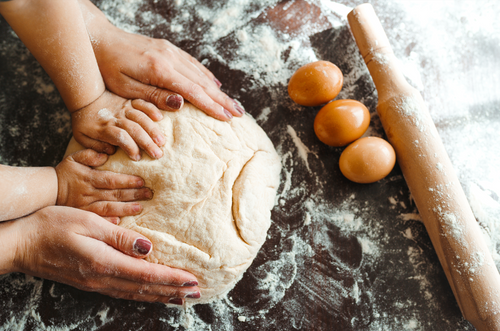No Products in the Cart

Making bread is almost an art. Or perhaps a science. In any case, with bread making, there are two kinds of leaveners typically used in the baking process. One is baking soda or powder, and the other is yeast.
Before talking about temperatures… let’s understand a bit about yeast. Yeast is a live fungal organism made of a single cell. Yeast has over 160 different species that live in us and all around us. The best type of yeast to use when making Gluten Free bread is the kind we use at Mom’s Place—it comes in little pre-measured packets—it’s Instant or Rapid Rise Yeast. These are best because it’s essential that yeast lie dormant until they come into contact with warm/hot water at just the right temperatures AND these are the easiest to use—when used correctly.
When warm/hot water hits the yeast, it reactivates it and “wakes it up.” Then it begins to eat and multiply. The yeast organism feeds on the simple sugars found in flours. As they feed, they release chemicals and gases like carbon dioxide and ethanol, along with energy and flavor molecules.
At what temperature can you see the best results when proofing your yeast? Good question. Yeast is a finicky little single-celled organism. There are several types used for baking and for baking breads. But we recommend Instant or Rapid Rise Yeast. Is there ever a time you can use higher water temperatures on yeast? Yes, but only when you are using instant yeast, like we provide in our mixes. Many people are surprised we ask for such a higher temperature to proof our yeast, but again, it is because this instant yeast requires it, and this instant yeast works best in gluten free baking, as will be discussed below.
How should you prepare the yeast to be mixed into your next batch of dough? This process is sometimes referred to as proofing the yeast. It is when you add yeast to water, then feed it sugar and stir it together. As the yeast sits in the water, it begins to dissolve and the yeast is activated. Once the yeast has been activated or “awakened,” it will begin to feed on the sugar in the water.
The next step when proofing yeast is to let the yeast mixture sit for several minutes. A good benchmark is to allow 2 to 3 minutes for it to completely dissolve, and then an additional 2 or 3 minutes for the yeast to start growing and show signs of life. So wait at least 5 – 6 mins total.
Signs of lively yeast include little surface bubbles on the top of the water. Depending upon how optimal your temperatures have been, sometimes the mixture may expand even more than you expect!
First, this type of yeast is activated at a higher temperature, with the sweet spot being 120-125°F.
We recommend using a ceramic mug (ceramic helps keep the heat in).
Run your tap water for a few minutes ‘til it’s really hot. Fill the mug w/ the proper amount of water (most recipes need approx. ¼ C.). Not sure if your water is the right temp? We recommend using a thermometer; these are also available on our website.
Then sprinkle sugar (follow the recipe but generally 1-2 teaspoons) overtop & stir. Then cover the mug with a plate (again to keep the heat in).
Let it sit for at least 5 minutes.
Now at this point, most people say, wait… my mom always said, “don’t get the water too hot! You’ll kill your yeast!” Well, she was referring to dry yeast—which is much more temperamental. If your water is too cold, the yeast will not activate. Then again, if your water is too hot, you will kill the little buggers and they will be useless. Typically, hot water somewhere in the range of 105° and 115°F is ideal for proofing dry yeast. However, dry yeast rarely performs in gluten free baking, thus it isn’t our recommended yeast.
This is part of the process used to give bread its rise, and it is sometimes referred to as the fermentation process. As the carbon dioxide gas expands, the bread dough rises. Yeast is also what gives the bread all of its yummy flavors and smells. Using the perfect amounts of baking powder or baking soda enhances the process of rising.
Because gluten free doughs don’t have traditional “gluten” we’ve carefully replaced it with specific combinations of other grains and blends that help it still perform “like” gluten. But our Instant yeast packets are still the secret to getting it to rise.
The short story is that without properly “feeding” the yeast, your bread won’t rise properly, and you won’t get the same look or flavor that you’d hope. Here’s why…
Once your yeast has been proofed, the next step is to begin stirring in your chosen Mom’s Place bread mix. Be careful that you stir in the flour & other ingredients together first as a bit of a buffer, because yeast organisms don’t like salt. If you pour the salt in first, then your yeast organisms will not be happy campers!
Of course, these tentative estimations can be higher or lower depending upon the type of yeast you are using, and whether it is active dry yeast, live yeast, or rapid rise yeast. The bottom line is that yeast thrives in warm water, sleeps in cold water, and dies in hot water. So, like Goldilocks and the Three Bears, it’s important to get the temperatures “just right” for your yeast to thrive and your delicious bread to obtain the best rise and flavors possible.
We are always here to help you achieve the flavors & products you’re striving to!
Thank you for being part of our Mom’s Place Gluten Free community.
Jann Craig, Founder
Mom’s Place Gluten Free